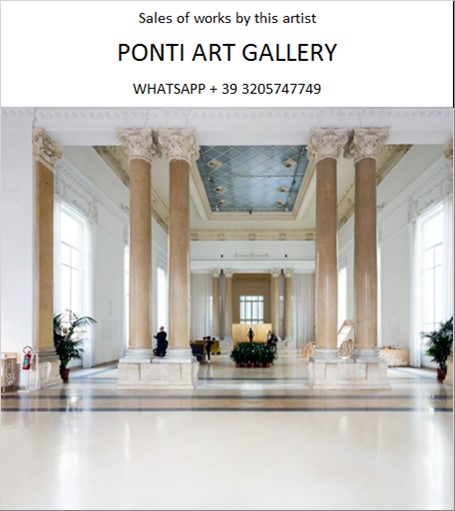Ponti Art Gallery is interested in buying and selling works
of art by this artist.

Nicolas Schoffer Biography
Nicolas Schöffer, born on September 6, 1912, in Kalocsa, Hungary, emerged as a pioneering figure in the realms of cybernetic and kinetic art, profoundly influencing the intersection of art and technology in the mid-20th century. His journey from a young law student in Budapest to a visionary artist in Paris encapsulates a remarkable transition, driven by his relentless pursuit of innovation and his profound engagement with the scientific advancements of his time.
Schöffer's early life in Hungary laid the foundation for his diverse interests. Encouraged by his violinist mother, he developed an artistic sensibility, while his lawyer father instilled in him practical values. Despite initially pursuing law studies due to concerns about the sustainability of an art career, Schöffer's passion for art remained undiminished. This dual influence of artistic inclination and practical sensibility would later become a hallmark of his work, blending creative vision with scientific precision.
In 1936, drawn by the broader artistic landscape and opportunities, Schöffer relocated to Paris, a move that marked the beginning of his transformative journey in the art world. His early works leaned towards expressionism and surrealism, but it was the International Exposition of Art and Technology in Paris that profoundly impacted him, steering his artistic direction towards the integration of scientific research with art. This pivotal experience reshaped his artistic style and set him on a path of innovation that would define his entire career.
By 1947, Schöffer's artistry began to flourish as he pioneered cybernetic sculptures, integrating light, movement, sound, and the progression of time. His work transcended traditional artistic boundaries, embodying a dynamic, ever-evolving force that engaged viewers in a multisensory experience. Schöffer's early metal sculptures, influenced by Constructivism and Neoplasticism, laid the groundwork for his later kinetic works, which explored the viewer's experience of space, light, and time.
Schöffer's innovative spirit was further fueled by his encounter with Norbert Wiener's cybernetic theories of control and feedback. This engagement with cybernetics allowed him to conceptualize art as a system rich with feedback loops, circular causality, and a fundamental emphasis on movement. His sculptures, such as CYSP 1, became living embodiments of Wiener's concepts, capable of interacting with their environment and viewers through electronic "brains" that governed their reactions based on feedback loops.
Throughout his career, Schöffer remained committed to the idea of art as a dynamic, interactive, and alive entity. He envisioned a new form of art that synthesized the material and the immaterial, the physical and the psychological, the past and the future. His emphasis on the role of the viewer was revolutionary, proposing that the artwork should respond to the viewer's presence, movements, and interactions, thus establishing a reciprocal relationship between the artwork and its audience.
Schöffer's contributions to the art world were not limited to his sculptures. He was also a painter, sculptor, architect, city planner, art theorist, and experimental artist who consistently pondered art's societal influence. His work in cybernetic art laid the groundwork for many contemporary artists who continue to explore the relationship between art, technology, and the viewer.
Despite his groundbreaking achievements, Schöffer's work has often been overlooked in art history. However, recent years have seen a resurgence of interest in his ideas, recognizing them as some of the most innovative and influential of the 20th century. Nicolas Schöffer passed away on January 8, 1992, in Paris, France, but his legacy continues to inspire new generations of artists exploring the potential of technology in their creative practices. Through his visionary work, Schöffer realized his goal of creating an art that is dynamic, interactive, and alive, leaving an indelible mark on the field of art and technology.
Nicolas Schoffer Quotes and
Sales of Works
Ponti Art Gallery selects and deals with paintings by the
artist. Upon request, we provide free estimates and
evaluations, communicate prices, quotations, and current
market values.
If you are interested in BUYING or SELLING works by the
artist, contact us immediately.
If you wish to sell or receive an evaluation of the
works:
Send us a frontal photo of the painting, one of the back,
and one of the signature. Also, indicate the dimensions of
the work. Inform us about the purchase origin of the work
and any kind of available documentation (purchase
receipts, certificates of authenticity, publications). One
of our operators will respond to you on the same day. We
guarantee maximum confidentiality and extreme
professionalism.
If you wish to purchase works by the painter: Contact us
and let us know your request. We will inform you about the
available works. We also offer the possibility to
subscribe to our NEWSLETTER, through which you will be
informed at the beginning of each month about the latest
acquisitions of the art gallery.
You can send us pictures of the work:
